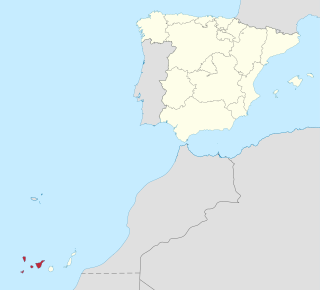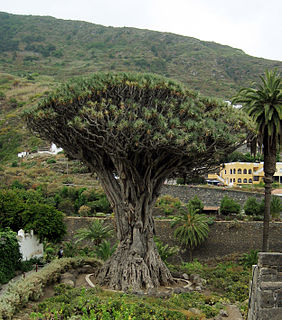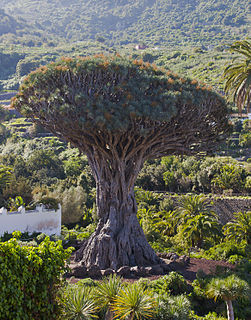
Province of Santa Cruz de Tenerife, also Province of Santa Cruz, is a province of Spain, consisting of the western part of the autonomous community of the Canary Islands. It consists of about half of the Atlantic archipelago: the islands of Tenerife, La Gomera, El Hierro, and La Palma. It occupies an area of 3,381 km2 (1,305 sq mi). It also includes a series of adjacent roques.

The Guanches were the aboriginal inhabitants of the Canary Islands. In 2017, the first genome-wide data from the Guanches confirmed a North African origin and that they were genetically most similar to modern North African Berber peoples of the nearby North African mainland. It is believed that they arrived on the archipelago some time in the first millennium BCE.

Tenerife is the largest and most populated island of the eight Canary Islands. It is also the most populated island of Spain, with a land area of 2,034.38 square kilometres (785 sq mi) and 917,841 inhabitants at the start of 2019, 43 percent of the total population of the Canary Islands. Tenerife is the largest and most populous island of Macaronesia.

Los Realejos is a town and a municipality in the northern part of the island of Tenerife, which is the biggest of the Canary Islands. It is part of the province of Santa Cruz de Tenerife, Spain. The town is located 2 km from the north coast, 5 km southwest of Puerto de la Cruz, 6 km west of La Orotava, and 34 km southwest of the island's capital Santa Cruz de Tenerife. The inhabitants are known in Spanish as realejeros.

Icod de los Vinos is a municipality in the province of Santa Cruz de Tenerife on the island of Tenerife, in the Canary Islands (Spain), located in the northwestern part of the island. Inhabitants of Icod are known in Spanish as "icodenses".

The First Battle of Acentejo took place on the island of Tenerife between the Guanches and an alliance of Spaniards, other Europeans, and associated natives, on 31 May 1494, during the Spanish conquest of this island. It resulted in a victory for the Guanches of Tenerife.

El Tanque is a town and a municipality in the northwestern part of the island of Tenerife, one of the Canary Islands, and part of the province of Santa Cruz de Tenerife, Spain. It is located 6 km west of Icod de los Vinos and 53 km west of the island's capital Santa Cruz de Tenerife.

La Guancha is a municipality in the northern part of the island of Tenerife, one of the Canary Islands, and part of the province of Santa Cruz de Tenerife. It is located about 40 km west of the island's capital Santa Cruz de Tenerife, and 6 km east of Icod de los Vinos. The population is 5,448 (2013) and the area is 23.77 km². The elevation is 501 m.

San Sebastián de La Gomera is the capital and a municipality of La Gomera in the Canary Islands, Spain. It also hosts the main harbour. The population was 8,699 in 2013, and the area is 113.59 square kilometres (43.86 sq mi).

Museo de la Naturaleza y Arqueología (MUNA), is a museum-based in Santa Cruz de Tenerife, Tenerife,. It contains many significant archaeological finds and is considered the best repository of objects from the Pre-Castilian Canary Islands. The museum also houses significant paleontological, botanical, entomological, and marine and terrestrial vertebrate collections, and is considered the best Natural Library of the Canary Islands.

The Mummy of San Andrés is a human mummy belonging to the Guanche culture, who were the ancient inhabitants of the Canary Islands, Spain.

The Archaeological Museum of Puerto de la Cruz is a small archaeological museum located in the town of Puerto de la Cruz. One of the most important local museums, it offers an archival collection comprising more than 2,600 specimens of the aboriginal Guanche culture, and a document collection named after researcher Luis Diego Cuscoy.

Icod or Icode is one of nine menceyatos guanches that was divided the island of Tenerife after the death of mencey Tinerfe.
Cueva del Viento is the largest lava tube system in Europe, and the fifth largest in the world, behind a series of lava tubes in Hawaii. It is also considered the most complex volcanic tube in the world, due to its morphology of several levels and passages.

The Guanche mummies of Necochea are two mummies of Guanche individuals, who were the ancient Berber autochthones of the Canary Islands. The specimens are currently on display at the Museo de la Naturaleza y el Hombre in Santa Cruz de Tenerife.

The Cave of the Guanches, or Archaeological area of the Cave of the Guanches, is an important archaeological site located in the north of the island of Tenerife.

The Caves of Don Gaspar is an important archaeological site located in the north of the island of Tenerife.

El Drago, also known as Drago Milenario and Drago de Icod de los Vinos, is the oldest and largest living specimen of Dracaena draco, or dragon tree, in Parque del Drago, Icod de los Vinos, Tenerife, Spain. It is said to be a thousand years old, although the age is disputed. It is one of the symbols of Tenerife, and was declared a national monument in 1917.

Drago Park is a park and one of the main visitor attractions in Icod de los Vinos, Tenerife. Created at the turn of the millennium, it contains El Drago Milenario, a dragon tree thought to be around 1,000 years old, as well as a variety of other native plants.


















